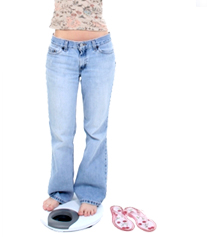|
 |
How To Measure Body FatBest Body Weight Management MethodIn order to maintain a healthy weight management program, you need to know how to measure your body fat accurately. Most people will simply step on a weighing scale, read the numbers and exclaimed, "Arrrrrgh! I have put on extra 2 kilos and I need to lose those unwanted weight." You know what? Body fat measurement on a weighing scale is unreliable. If you lose weight, how would you know that you were not losing fat but muscles, or water, or the food you have eaten? Or if you have put on weight, could it be from the muscle weight you have worked so hard for? Or could it be the heavy meal you have eaten or from the beer you have just drunk? So your weight will fluctuate if you use the weight scale as your body fat measurement. Then what other methods of weight measurements can you measure your body fat more accurately? Well, most methods of body fat weight measurement have their pros and cons but are usually more accurate than the simple bathroom scales. Here are two of the more common body fat measurement methods for effective weight management. ?Body Mass Index Measurement (BMI) Body Mass Index body fat measurement method take your weight and height into consideration that will give you an indication of whether you are obese and overweight or in a great body shape. It is a calculation formula: BMI = kg/m2 A healthy BMI score is between 18 and 25. A score below 18 indicates that you may be underweight; a value above 25 indicates that you may be overweight. However, BMI weight measurement method may not be accurate if you are an athlete or a bodybuilder with more muscle mass than an average person. ?Waist To Hip Measurement Waist to hip method of body fat measurement is thought to be more important than the BMI method. This is because it measures visceral fat which are normally accumulated as abdominal fat and can also be found in the organs which are considered more dangerous than normal body fat. To measure your waist to hip ratio, measure your waist at your navel and your hips at its widest point (usually at the butt cheeks) then divide your waist by your hips. Your waist to hip measurement should be 0.92 or lower. More than that would mean that you are accumulating more visceral and body fat in that area and is an indication of susceptibility to obesity related diseases. If you find that remembering formulae and number crunching are chores to you, there are equipment you can buy to help you measure your body fat for your weight management program such as calipers and electronic body fat percentage calculator. Armed with more accurate body fat measurement, then you can plan your weight management program more effectively whether to lose extra weight or gain healthy weight. Chris Chew is a personal trainer of pageant winners, models, actors and other celebrities. He is the author of Burn Fat Build Muscles Fast. His fitness outfit Fitness Trainers Singapore Weight Loss Arreglarse Las Uas es Bsico para las Relaciones - Arreglarse las uñas y mejorar la presentación personal permite que sus relaciones personales mejoren y hasta consiga un mejor trabajo. The Truth about Plastic Sugery Abroad - About plastic surgery abroad. Discover Motivation Via Hypnosis And Hypnotherapy Home Study Course - Selfhypnosis has been peddled by not a few as a solution to various problems ranging from stress to pain relief and even sleeping disorders. What Does Eye Surgery Entail - Amore permanent solution for many individuals exists with a laser eye surgery procedure such as LASIK. Deli Sandwich For Lunch Pizza For Dinner Is This Your Staple Diet - What's in your lunch box? Is the local sandwich deli your standard lunch time meal? This and the pizza on the way home from the office may be your reasons for piling on those kilos. more... |
|
|
|
|
|
© Copyright 2026 terredimages.com All rights reserved. |